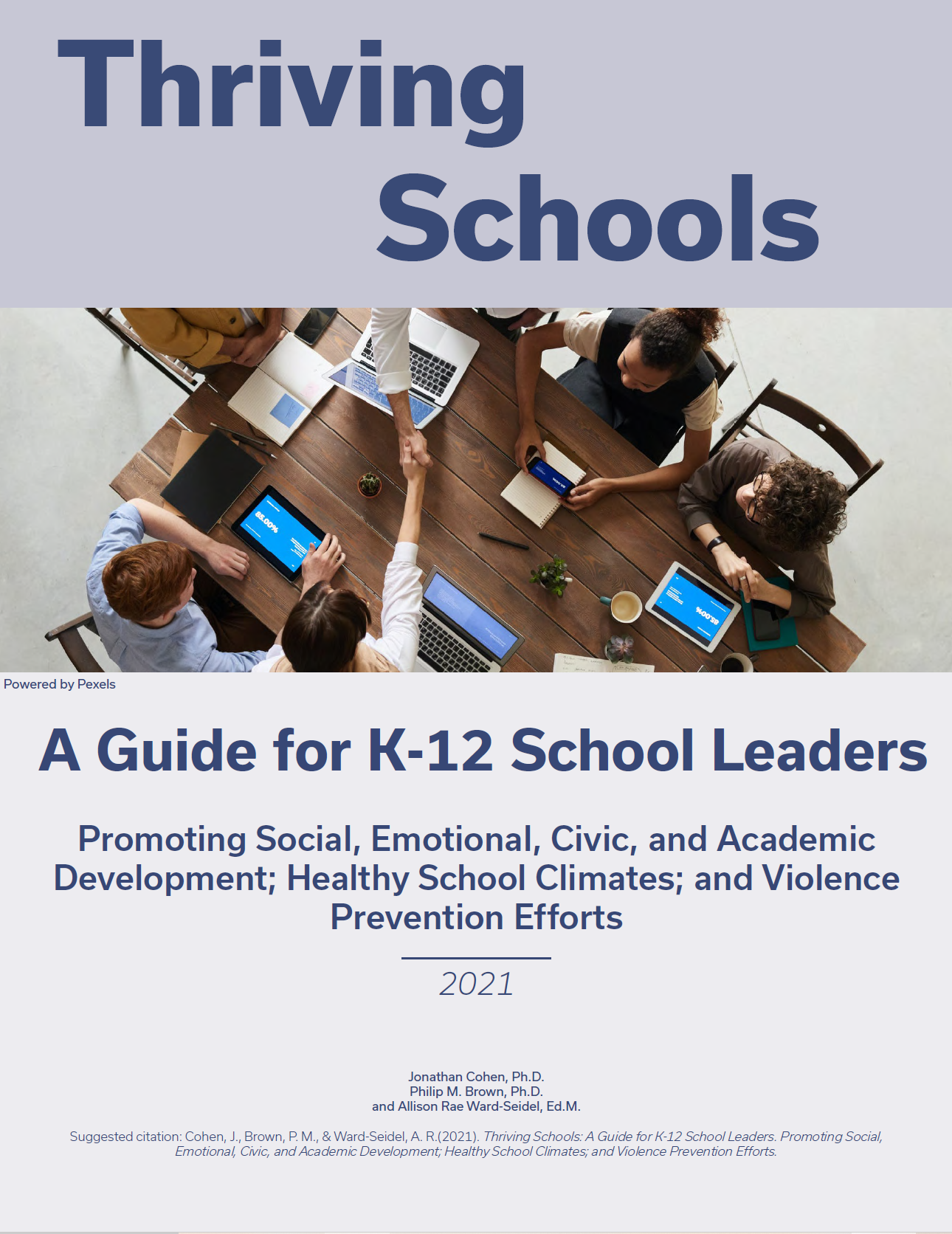Articles
- Aarons, G. A., Hurlburt, M., & Horwitz, S. M. (2011). Advancing a conceptual model of evidence- based practice implementation in public service sectors. Administration and Policy in Mental Health and Mental Health Services Research, 38, 4–23.
- Astor, R. A., Noguera, P., Fergus, E., & Gadsden, V. (2021). A Call for the Conceptual Integration of Opportunity Structures Within School Safety Research. School Psychology Review, 1–19.
- Benbenishty, R., & Astor, R. A. (2020). School and Student Level Prevalence and Predictors of Weapon-Related Behaviors and Experiences Among Secondary Schools in California. SSRN Electronic Journal.
- Blasé, K., van Dyke, M., & Fixsen, D. (2013). Implementation drivers: Assessing best practices. Adapted with permission by The State Implementation & Scaling up of Evidence based Practices Center (SISEP), University of North Carolina, Chapel Hill.
- Blaya, C., Audrin, C., & Skrzypiec, G. (2020). School Bullying, Perpetration, and Cyberhate: Overlapping Issues. Contemporary School Psychology, 2013(2015).
- Cohen, J., Thapa, A. & Higgins-D’Alessandro, A. (2017). School Climate/Social Emotional Learning Measurement Systems: Trends, Contributions, Challenges and Opportunities. Journal of Educational Leadership and Policy, 1, 117-139. ISSN#: 2473-2826.
- Cohen, J., Brown, P. M., & Ward-Seidel, A. R. (2022). Des écoles prospères : Guide à l’intention des directions d’établissements scolaires de la maternelle à la 12e année. Promouvoir le développement émotionnel, social, civique et scolaire, un climat scolaire sain et prévenir la violence (Traduit par C. Beaumont et J. Boissonneault).
- Cohen, J., Brown, P. M., & Ward-Seidel, A. R. (2024). Processos para melhoria contínua das escolas: Guia para equipes gestoras da educação básica [Translated by Dr. Adriano Moro (Coord.), Darrell Champlin and Fernando Effori de Mello].
- Costa, A. P., & Steffgen, G. (2020). After the move to a new campus—effects on students’ satisfaction with the physical and learning environment. Education Sciences, 10(12), 1–13.
- Damschroder, L. J., Aron, D. C., Keith, R. E., Kirsh, S. R., Alexander, J. A., & Lowery, J. C., (2009). Fostering Implementation of health services research findings into practice: A consolidated framework for adapting implementation science. Science, 4(50).
- Dietrich, L., & Cohen, J. (2019). Explaining classroom bullying climates: The role of student body composition, relationships, and teaching quality. International Journal of Bullying Prevention, 3, 34-47.
- Dietrich, L., & Zimmermann, D. (2019). How aggression-related mindsets explain SES-differences in bullying behavior. Emotional & Behavioural Difficulties, 24(2), 181-195.
- Drzensky, F., Egold, N., & Van Dick, R. (2012). Ready for a change? A longitudinal study of antecedents, consequences, and contingencies of readiness for change. Journal of Change Management, 12(1), 95–111.
- Fixsen, D. L., Naoom, S. F., Blasé, K. A., Friedman, R. M. & Wallace, F. (2005). Implementation Research: A Synthesis of the Literature. Tampa, FL: University of South Florida, Louis de la Parte Florida Mental Health Institute, The National Implementation Research Network (FMHI Publication #231).
- Fullan, M. (2011). Choosing the wrong drivers for whole system reform. Centre for Strategic Education Seminar Series Paper, 204.
- Greenhalgh, T., Robert, G., MacFarlane, F., Bate, P., & Kyriakidou, O. (2004). Diffusion of innovations in service organizations: Systematic review and recommendations. The Milbank Quarterly, 82(4), 581–629.
- Lambert-Samson, V., & Beaumont, C. (2018). Classroom anxiety in students as perceived by elementary school teachers. Enfance En Difficulté, 5, 101.
- Marín-López, I., Zych, I., Ortega-Ruiz, R., Monks, C. P., & Llorent, V. J. (2020). Empathy online and moral disengagement through technology as longitudinal predictors of cyberbullying victimization and perpetration. Children and Youth Services Review, 116(June), 105144.
- Moore, H., Astor, R. A., & Benbenishty, R. (2020). Role of school-climate in school-based violence among homeless and nonhomeless students: Individual- and school-level analysis. Child Abuse and Neglect, 102(January), 104378.
- Ojeda, M., Del Rey, R., Walrave, M., & Vandebosch, H. (2020). Sexting in adolescents: Prevalence and behaviours. Comunicar, 28(64), 9–18.
- Pinheiro, V., Zambianco, & Moro, A. (2022). Education in sensitive times: contributions of moral and socioemotional skills in the context of the pandemic and post Covid-19. Revista Iberoamericana de Estudios en Educación, 17(1), 3-20.
- Powell, B. J., McMillen, J. C., Proctor, E. K., Carpenter, C. R., Griffey, R. T., Bunger, A. C., York, J. L. (2012). A compilation of strategies for implementing clinical innovation in health and mental health. Medical Care Research and Review, 69(2), 123–157
- Rafferty, A. E., Jimmieson, N. L., & Armenakis, A. (2013). Change readiness. A multilevel review. Journal of Management, 39(1), 110–135.
- Romera, E. M., Camacho, A., Ortega-Ruiz, R., & Falla, D. (2021). Cybergossip, cyberaggression, problematic Internet use and family communication. Comunicar, 67, 1-10.
- Skrzypiec, G., Alinsug, E., Amri Nasiruddin, U., Andreou, E., Brighi, A., Didaskalou, E., Guarini, A., Heiman, T., Kang, S. W., Kwon, S., Olenik-Shemesh, D., Ortega-Ruiz, R., Romera, E. M., Roussi-Vergou, C., Sandhu, D., Sikorska, I., Wyra, M., Xi, J., & Yang, C. C. (2021). Harmful Peer Aggression in Four World Regions: Relationship between Aggressed and Aggressor. Journal of School Violence, 20(1), 1–16.
- Van Ouytsel, J., Walrave, M., Ojeda, M., Del Rey, R., & Ponnet, K. (2020). Adolescents’ sexy self-presentation on instagram: An investigation of their posting behavior using a prototype willingness model perspective. International Journal of Environmental Research and Public Health, 17(21), 1–15.
- Velázquez Reyes, L. M., Reyes Jaimes, G. R., & Espinoza Ávila, L. (2021). De la ciberviolencia a la violencia física: el día que Holk irrumpió en la prepa. Revista Educación, 45(1), 1-16.
- Weiner, B. J., Amick, H., & Lee, S. (2008). Conceptualization and measurement of organizational readiness for change: A review of the literature in health services research and other fields. Medical Care Research and Review, 65(4), 379–436.
- Zych, I., Ttofi, M. M., Llorent, V. J., Farrington, D. P., Ribeaud, D., & Eisner, M. P. (2020). A Longitudinal Study on Stability and Transitions Among Bullying Roles. Child Development, 91(2), 527–545.
Books and Guides
- Cohen, J., Brown, P. M., & Ward-Seidel, A. R. (2021). Thriving Schools: A Guide for K-12 Schools Leaders. Promoting Social, Emotional, Civic, and Academic Development; Healthy School Climates; and Violence Prevention Efforts.
- Bryk, A.S., Gomez, L.M, Grunow, Al & LeMahieu, P.G. (2015). Learning to improve: How America’s Schools Can get Better at Getting Better. Harvard Educational Press.
- Cohen, J., & Espelage, D. (2020). Feeling Safe in School: Bullying and Violence Prevention Around the World. Harvard Education Press.
- Hord, S. M. (1990). Realizing school improvement through understanding the change process. Southern Educational Development Lab.
- Hord, S. M., Rutherford, W.L., Huling-Austin, L., & Hall, G.E. (1987). Taking charge of change. ASCD.
- Fullan, M. (2014). The principal: Three keys to maximizing impact. San Francisco, CA: Jossey-Bass.
- Fullan, M. & Quinn, J. (2015). Coherence: The right drivers in action for schools, districts, and systems. Corwin Press.
- Sánchez-Jiménez, V. (coord.) (2019). Prevención de la violencia interpersonal en la infancia y la adolescencia. Ediciones Pirámide.
- Sarason, S.B. (1996). New York: Revisiting “The culture of the school and the problem of change. Teachers College Press.
- Schultz, K. (2019). Distrust and educational change: Overcoming barriers to just and lasting reform. Harvard Educational Press.



